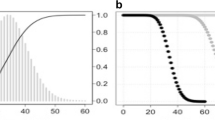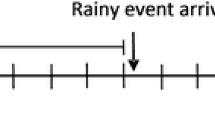Abstract
In this paper, we consider a Markov renewal process (MRP) to model tropical cyclones occurred in Bangladesh during 1877–2009. The model takes into account both the occurrence history and some physical constraints to capture the main physical characteristics of the storm surge process. We assume that the sequence of cyclones constitutes a Markov chain, and sojourn times follow a Weibull distribution. The parameters of the Weibull MRP jointly with transition probabilities are estimated using the maximum likelihood method. The model shows a good fit with the real events, and probabilities of occurrence of different types of cyclones are calculated for various lengths of time interval using the model. Stationary probabilities and mean recurrence times are also calculated. A brief comparison with a Poisson model and a marked Poisson model has also been demonstrated.






Similar content being viewed by others
References
Ali A (1996) Vulnerability of Bangladesh to climate change and sea level rise through tropical cyclones and storm surges. Water Air Soil Pollut 92(1):171–179
Alvarez E (2005) Estimation in stationary Markov renewal processes, with application to earthquake forecasting in Turkey. Methodol Comput Appl Prob 7(1):119–130
Asaduzzaman M, Latif AHMM (2014) Computational intelligence techniques in earth and environmental sciences chap 7. Springer, New York
Dube S, Sinha P, Roy G (1985) The numerical simulation of storm surges along the Bangladesh coast. Dyn Atmos Oceans 9(2):121–133
Dube S, Sinha P, Roy G (1986) Numerical simulation of storm surges in Bangladesh using a bay-river coupled model. Coast Eng 10(1):85–101
Fiorentino M, Versace P, Rossi F (1984) Two component extreme value distribution for flood frequency analysis. Water Resour Research 20(7):847–856
Garavaglia E, Pavani R (2011) About earthquake forecasting by Markov renewal processes. Methodol Comput Appl Prob 13(1):155–169
Gospodinov D, Rotondi R (2001) Exploratory analysis of marked Poisson processes applied to Balkan earthquake sequences. J Balkan Geophys Soc 4(3):61–68
Gregory J, Wigley T, Jones P (1993) Application of Markov models to area-average daily precipitation series and interannual variability in seasonal totals. Clim Dyn 8(6):299–310
Gupta V, Duckstein L (1975) A stochastic analysis of extreme droughts. Water Resour Res 11(2):221–228
Haque C (1995) Climatic hazards warning process in Bangladesh: experience of, and lessons from, the 1991 April cyclone. Environ Manag 19(5):719–734
Haque C, Blair D (1992) Vulnerability to tropical cyclones: evidence from the April 1991 cyclone in coastal Bangladesh. Disasters 16(3):217–229
Islam T, Peterson R (2009) Climatology of landfalling tropical cyclones in Bangladesh 1877–2003. Nat Hazards 48(1):115–135
Jagger T, Niu X, Elsner J (2002) A space-time model for seasonal hurricane prediction. Int J Climatol 22(4):451–465
Janssen J, Manca R (2007) Semi-Markov risk models for finance, insurance and reliability. Springer, New York
Khalil G (1992) Cyclones and storm surges in Bangladesh: some mitigative measures. Nat Hazards 6(1):11–24
Lardet P, Obled C (1994) Real-time flood forecasting using a stochastic rainfall generator. J Hydrol 162(3–4):391–408
Limnios N, Oprian G (2001) Semi-Markov processes and reliability. Springer, New York
Lu Y, Garrido J (2005) Doubly periodic non-homogeneous Poisson models for hurricane data. Stat Methodol 2(1):17–35
Masala G (2012a) Earthquakes occurrences estimation through a parametric semi-Markov approach. J Appl Stat 39(1):81–96
Masala G (2012b) Hurricane lifespan modeling through a semi-Markov parametric approach. J Forecast doi:10.1002/for.2245
Mooley D (1981) Applicability of the Poisson probability model to the severe cyclonic storms striking the coast around the Bay of Bengal. Sankhyā: Indian J Stat Series B 43(2):187–197
Ogata Y (1988) Statistical models for earthquake occurrences and residual analysis for point processes. J Am Stat As 83(401):9–27
Ogata Y (1998) Space-time point-process models for earthquake occurrences. Ann Inst Stat Math 50(2):379–402
Pyke R (1961) Markov renewal processes: definitions and preliminary properties. Ann Math Stat 32(4):1231–1242
Rumpf J, Weindl H, Höppe P, Rauch E, Schmidt V (2007) Stochastic modelling of tropical cyclone tracks. Math Methods Oper Res 66(3):475–490
Sinha P, Dube S, Roy G, Jaggi S (1986) Numerical simulation of storm surges in Bangladesh using a multi-level model. Int J Numer Meth Fluids 6(5):305–311
Votsi I, Limnios N, Tsaklidis G, Papadimitriou E (2012) Estimation of the expected number of earthquake occurrences based on semi-Markov models. Methodol Comput Appl Prob 14(3):685–703
Acknowledgements
The authors would like to thank the Referees for their constructive comments and helpful suggestions for the improvement of this paper.
Author information
Authors and Affiliations
Corresponding author
Rights and permissions
About this article
Cite this article
Asaduzzaman, M., Latif, A.H.M.M. A parametric Markov renewal model for predicting tropical cyclones in Bangladesh. Nat Hazards 73, 597–612 (2014). https://doi.org/10.1007/s11069-014-1101-z
Received:
Accepted:
Published:
Issue Date:
DOI: https://doi.org/10.1007/s11069-014-1101-z




